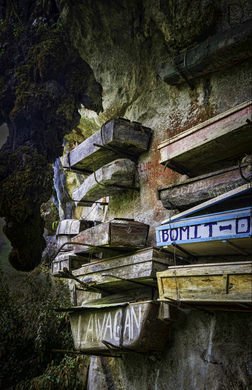There is an old tradition in Sagada where people hang their coffins in limestone caves. It was carried out by the Igorot tribe of Mountain Province, which became a common belief among the people in the northern Philippines.
They believe that this ritual prevents monsters and beasts from taking the dead bodies, and also purifies or blesses the departed soul. The people of Sagada follow a unique burial ritual. The elderly carve their own coffins out of hollowed logs. If they are too weak or ill, their families prepare their coffins instead.
The dead are placed inside their coffins (sometimes breaking their bones in the process of fitting them in), and the coffins are brought to a cave for burial. Instead of being placed into the ground, the coffins are hung either inside the caves or on the face of the cliffs, near the hanging coffins of their ancestors.
The Sagada people have been practicing such burials for over 2,000 years, and some coffins are well over a century old. Eventually, the coffins deteriorate and fall from their precarious positions. The reason the coffins were hung was due to the belief that the higher the dead were placed, the greater chance of their spirits reaching a higher nature in the afterlife.
Many of the locations of the coffins are difficult to reach (and obviously should be left alone out of respect) but can be appreciated from afar. When someone dies, pigs and chickens are traditionally butchered for community celebrations.
For elderly people, tradition dictates this should be three pigs and two chickens, but those who cannot afford to butcher so many animals may butcher two chickens and one pig.
Soledad tells me the number must always be three or five. The deceased is then placed on a wooden sanga dil, or death chair, and the corpse is tied with rattan and vines, and then covered with a blanket. It is thereafter positioned facing the main door of the house for relatives to pay their respects.
The cadaver is smoked to prevent fast decomposition and as a means to conceal its rotting smell. The vigil for the dead is held for a number of days, after which the corpse is removed from the death chair to be carried to the coffin.
Before being taken for burial, it is secured in the fetal position, with the legs pushed up towards the chin. It is then wrapped again in a blanket and tied with rattan leaves while a small group of men chips holes into the side of the cliff to hammer in the support for the coffin.
“The corpse is wrapped like a basketball”, says Soledad, “on the way there, mourners do their best to grab it and carry it because they believe it is good luck to be smeared with the dead’s blood.”
The fluids from the corpse are thought to bring success and to pass on the skills of the deceased to those who come into contact with them during the funeral procession. Today, Sagada’s elders are among the last practitioners of these ancient rituals.
Younger generations have adopted modern ways of life and are influenced by the country’s profound Christian beliefs. “Children want to remember their grandparents but they prefer to bury them in the cemetery and visit their tombs on All Saints Day. You can’t climb and visit the hanging coffins. It’s a tradition that is slowly coming to an end. It’s dying out.”
The post SCARY!! Did You Know There Is A Place In The Philippines Where They Hang Coffins? They Do It To Prevent Animals From Taking The Dead Bodies Away! appeared first on illuminaija.



